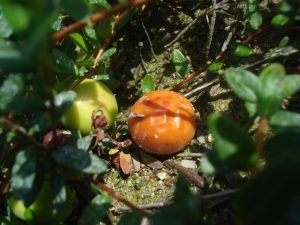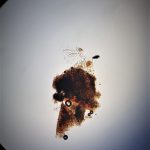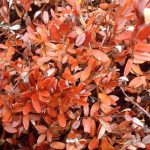Fruit Rot
Notes About Cranberry Fruit Rot:

- Fruit rot is the most prevalent disease problem that cranberry growers face from season to season, and there are at least 15 species of pathogenic fungi that are associated with it, and several more species that are suspected to be involved with it in one way or another.
- Some species of fruit rot fungi are believed to cause exclusively “field rot” (rot that occurs in the field before harvest), some are considered to cause exclusively “storage rot” (rot that occurs post-harvest), while still others appear to contribute to both field rot and storage rot, such as “Blotch Rot” which is pictured below.
- The fungal spores land on the blossom (by wind and wind-driven rain) or small developing fruit and–if there is a suitable layer of moisture present for six to eight hours–the plant tissue may succumb to fungal infection.
- Excess nitrogen, poor drainage, and a dense canopy (wet vines) are some of the key factors that are favorable to fruit rot infection.
-
Symptoms: Sometimes there is overlap among the fungi that cause field and storage fruit rots, butin general:
-
Pre-Harvest (infecting young berries still on the vines): culprit is often Early Rot (look for round, circular, discolored splotches that take on a bull’s eye pattern of alternating dark and light rings that eventually expand outwards until the entire berry is rotten). Early Rot is caused by Phyllosticta vaccinii, and can cause severe losses in the field where the growing season is typically long and warm, such as in New Jersey and Massachusetts. The fungus can attack flowers and young berries, as well as stems and leaves, but only in the berries does the damage level reach economic concern. Some less common field rot possibilities are Bitter Rot, Blotch Rot, and Hard Rot—the secondary stage of Cottonball disease.
-
Post-Harvest / Storage rots:
-
Black Rot: If there is a dark black color eight or more weeks after harvest, and the berry is relatively firm and dry, it is likely Black Rot. Black Rot is caused by three separate fungi: Allantophomopsis cytisporea, Allantophomopsis lycopodina, and Strasseria geniculata.
-
End Rot: If it is seen first at the blossom end of the berry (typical of this rot), and the rotted tissue is soft and watery and berry is elastic to the touch and possibly floating due to gas produced during the rotting process, then it is likely End Rot (berries with End Rot are called “poppers” because even though they are elastic, if pressed too hard they will burst). End Rot is caused by the fungus Godronia cassandrae f. vaccinii and occurs in all cranberry-growing regions of the country. Not unlike the case with Early Rot, End Rot can cause a twig blight and a kind of leaf spot along with its fruit-rotting ability, but it’s only the latter makeup of this fungus that is economically important.
-
Viscid Rot: If the rotting area is viscous and stringy, and the berry is soft and off-color, it is likely Viscid Rot (the word ‘viscid’ describes a surface that is sticky, as though coated with a syrupy secretion) (Viscid Rot is technically a field rot, but most of the rotting occurs in storage). Viscid Rot is caused by the fungus Phomopsis vaccinii.
-
-
- Microscopic image of Blotch Rot fungus (a primary pathogen involved in Cranberry Field Rot and also a pathogen associated with Cranberry Storage Rot) — Physalospora vaccinii (Maine, November 2018)
- Closer View of Blotch Rot fungus (Maine, Nov. 2018). The asci capsules–singular ascus–can be clearly seen; these capsules (which resemble pea pods) contain the sexual spores that are later released from the capsules.
- Cranberry vines infected with Blotch Rot fungus (various fruit rot fungi can infect the leaves as well as the fruit). Blotch rot sporulates on dead or dying leaves and only rarely sporulates on the berries (Maine; November 1st, 2018)
- If conditions are favorable and the cultivar is susceptible, berries may show rot symptoms one week after fungal infection (unfavorable conditions just means it takes longer). Interestingly, in the case of Blotch Rot pictured above, university of Wisconsin research has found that 40 to 60% of rotten cranberries from a given site will typically contain the blotch rot fungus. However, this species of fungus has also been found in 10 to 30% of healthy cranberry fruit, indicating that its presence does not always lead to disease expression.
- Failure to get good fruit rot control is usually not due to fungicide resistance! Poor fungicide timing is often the more likely culprit.
- Holding a ‘Late-water flood’ significantly reduces the level of fruit rot inoculum on a bed and it will improve berry ‘keeping quality’ as well. Lower fungicide rates (as low as the minimum rates on product labels permit) can usually be used, as well as fewer fungicide applications, in the year the flood is used. In Massachusetts, researchers have found that the benefits continue somewhat into the following year as well such that fungicide applications and rates can still be reduced without a discernible loss in fruit quality.
- One’s first fruit rot fungicide application should be applied no later than when half the cranberry flowers are open (i.e. 50% in bloom) and ideally before that point (as early as 10% of the flowers open).
- Once berries start to ‘size up,’ fungicides aren’t much help (any infections have already occurred by that point).
- One or two fruit rot sprays appears to be sufficient for most of Maine for controlling cranberry fruit rot; still seeing a need for (and recommending) three to four fungicide applications in Massachusetts, however, at 7 to 14 days apart.
Further/Recommended Reading:
Cranberry Fruit Rot (pdf) (University of Wisconsin-Extension)



